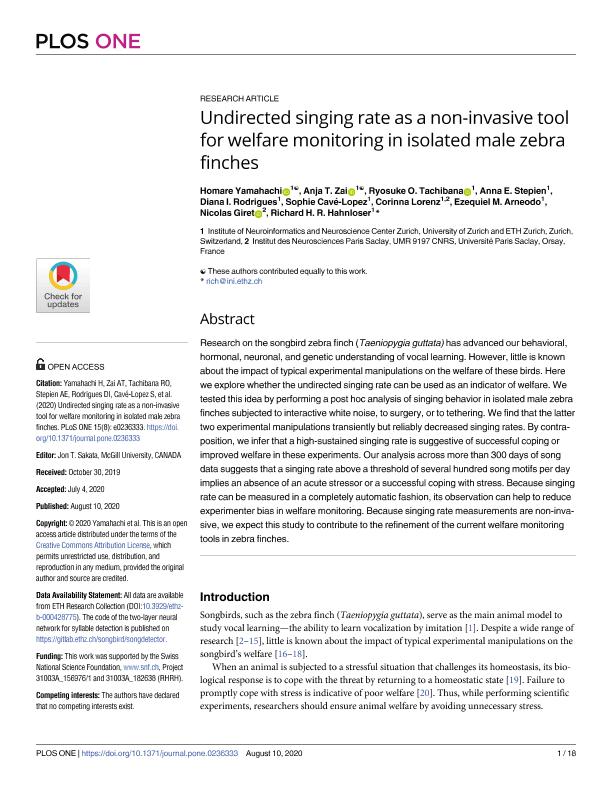Artículo
Undirected singing rate as a non-invasive tool for welfare monitoring in isolated male zebra finches
Yamahachi, Homare; Zai, Anja T.; Tachibana, Ryosuke O.; Stepien, Anna E.; Rodrigues, Diana I.; Cavé Lopez, Sophie; Lorenz, Corinna; Arneodo, Ezequiel Matías ; Giret, Nicolas; Hahnloser, Richard H. R.
; Giret, Nicolas; Hahnloser, Richard H. R.
 ; Giret, Nicolas; Hahnloser, Richard H. R.
; Giret, Nicolas; Hahnloser, Richard H. R.
Fecha de publicación:
08/2020
Editorial:
Public Library of Science
Revista:
Plos One
ISSN:
1932-6203
Idioma:
Inglés
Tipo de recurso:
Artículo publicado
Clasificación temática:
Resumen
Research on the songbird zebra finch (Taeniopygia guttata) has advanced our behavioral, hormonal, neuronal, and genetic understanding of vocal learning. However, little is known about the impact of typical experimental manipulations on the welfare of these birds. Here we explore whether the undirected singing rate can be used as an indicator of welfare. We tested this idea by performing a post hoc analysis of singing behavior in isolated male zebra finches subjected to interactive white noise, to surgery, or to tethering. We find that the latter two experimental manipulations transiently but reliably decreased singing rates. By contraposition, we infer that a high-sustained singing rate is suggestive of successful coping or improved welfare in these experiments. Our analysis across more than 300 days of song data suggests that a singing rate above a threshold of several hundred song motifs per day implies an absence of an acute stressor or a successful coping with stress. Because singing rate can be measured in a completely automatic fashion, its observation can help to reduce experimenter bias in welfare monitoring. Because singing rate measurements are non-invasive, we expect this study to contribute to the refinement of the current welfare monitoring tools in zebra finches.
Archivos asociados
Licencia
Identificadores
Colecciones
Articulos(IFLP)
Articulos de INST.DE FISICA LA PLATA
Articulos de INST.DE FISICA LA PLATA
Citación
Yamahachi, Homare; Zai, Anja T.; Tachibana, Ryosuke O.; Stepien, Anna E.; Rodrigues, Diana I.; et al.; Undirected singing rate as a non-invasive tool for welfare monitoring in isolated male zebra finches; Public Library of Science; Plos One; 15; 8; 8-2020; 1-18
Compartir
Altmétricas



